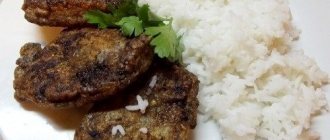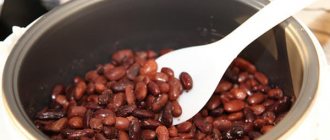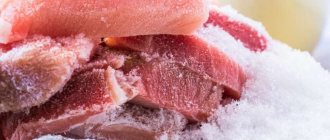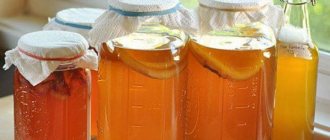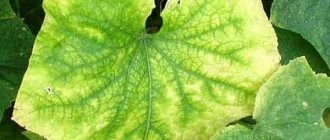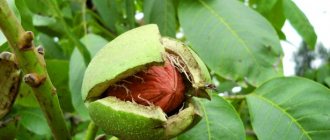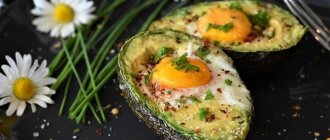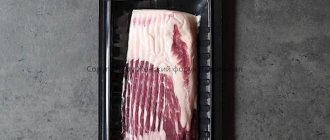I can’t resist and want to tell you about another very, cool way to prepare such a miracle product as Jerusalem artichoke. Less words and just learn how to pickle Jerusalem artichoke according to one of Grandmother’s recipes. Why one at a time? Because there are a couple more, but I like this method the most. Marinated Jerusalem artichoke turns out very tasty, tender and with a unique taste.
- We will need:
- Jerusalem artichoke.
- Water.
- Carrots (large) -1 pc.
- Garlic - 1 head.
- Vinegar 9% - ¾ cup.
- Coriander-1 gr.
- Black peppercorns - 2-3 pcs.
- Salt.
- How to cook:
- We select medium-sized Jerusalem artichoke tubers. Then wash them thoroughly in cold water with a soft brush, then remove all antennae and shoots.
- Sterilize a glass jar with steam and place the tubers tightly in it.
- In a saucepan, prepare the brine at the rate of 2 liters of water and 4 tablespoons of salt. After the water boils, turn off the heat, let it cool a little and pour the brine into a jar with Jerusalem artichoke. So that the water covers the entire Jerusalem artichoke.
- Cover tightly with a lid and leave at room temperature for 4 days.
- After the specified time, drain the brine.
- Cut large carrots into small cubes, peel the head of garlic, and cut into cloves.
- Then we transfer the Jerusalem artichoke with the prepared products.
- Prepare the marinade. Put 2 liters of water on the fire, bring to a boil, add ¾ cup of vinegar, one gram of coriander, turn off the heat immediately.
- Pour the hot marinade over the Jerusalem artichoke, close it again tightly with lids, and leave at room temperature for 3 days.
- Then, after this period, put the Jerusalem artichoke on a plate and eat.
This is how easy it is for you to pickle Jerusalem artichoke and enjoy its unique taste. Marinated Jerusalem artichoke is not only tasty but also healthy. If you like this recipe, write in the comments, and I will share with you even more delicious recipes for pickling Jerusalem artichoke. Watch the more useful video at the bottom of the article and stay with us. Bon appetit.
User comments (5 comments)
I really didn’t think that marinated Jerusalem artichoke was so delicious. You know, I’ll try it, although I prefer fresh. My husband loves canned food and I’ll make it for him. Thank you. I'm sharing! Thank you))))))
Be sure to try it, very tasty.
I haven’t tried pickled one yet, but I think it will be delicious, I prefer fresh or add it to salads. I would like to know a few more recipes.
Features of Jerusalem artichoke - medicine on your table
It can easily be classified as a medicinal plant. Vitamins, amino acids and other useful elements - Jerusalem artichoke is full of them. It’s simply surprising why such a valuable plant has not yet settled on our tables as a necessary product. But, for example, in Asia, it is very popular. And it is right!
Regular consumption of earthen pear will help normalize blood sugar levels - this is especially important for diabetics and obese people. With its help you can easily combat ailments such as anemia and iron deficiency. And most importantly, Jerusalem artichoke is an excellent assistant in cancer prevention.
I would also like to note that this plant is completely unpretentious. The small amount of planting material produces a very good harvest. Interestingly, Jerusalem artichoke survives the winter well in the ground. That is, it is not necessary to remove it for the winter; you can leave it until spring. And then Jerusalem artichoke becomes a real find for everyone. After all, the taste and beneficial properties of the vegetable after wintering remain at the same level. Or dig up some and store it in the cellar.
The advantages of Jerusalem artichoke include its versatility. Even the most demanding gourmet will find his favorite recipes. It is used to bake casseroles, fry pancakes and pancakes, cook soups, prepare excellent fillings and make salads. For diabetics and heart patients, coffee is brewed from dried root vegetables; this drink perfectly cleanses the blood and blood vessels.
Pickled Jerusalem artichoke - storage methods
There is one drawback to this gift of nature - it does not last long in the cellar, like potatoes and other root vegetables. Therefore, Jerusalem artichoke marinated for the winter is an excellent solution for continuous consumption of the product. All vitamins and beneficial elements are preserved as much as possible in the pickled root vegetable. It makes a very tasty and original snack.
The preparation is served both as an independent dish and as an addition to salads. There are a lot of recipes for pickling it. The procedure itself is simple and does not take much time. Jerusalem artichoke is so versatile that you can pickle it according to your favorite pickling cucumber recipe. In any case, as a result you will receive a tasty and high-quality product.
How to pickle Jerusalem artichoke - recipes
Jerusalem artichoke is marinated both in peeled form and with skin. We recommend trying both options. First of all, the roots must be well cleaned of soil. Then they are washed; if vegetables with skins are to be pickled, they need to be thoroughly cleaned with a brush. All roots and tendrils are cut off with scissors. We place the prepared whole root vegetable with skin tightly into a sterilized container.
Prepare the brine - add 4 tablespoons of salt to 2 liters of boiling water. After boiling, let the brine cool slightly; after 15 minutes, completely cover the Jerusalem artichoke with it. Cover the jar with a lid and put it in a dark, cool place for exactly a week. After this, drain the brine, add garlic cloves and peppercorns to the jar. Prepare the marinade. To do this, bring 2 liters of water to a boil again, then add ¾ cup of vinegar and coriander. Remove the marinade from the heat and pour into jars. After 3 days the product is ready for use.
A simple and original recipe - pickled root vegetables with lemon. For 1 kilogram of peeled and cut into pieces we need 1 lemon, 600 ml of water and 200 g of sugar.
Fill the prepared Jerusalem artichoke with salted water and set aside. At this time we are making marinade. To do this, finely chop the well-washed lemon along with the skin. Place it in a saucepan and fill it with boiling water. Boil for 5 minutes over low heat. Stirring constantly, add sugar. After the sugar has dissolved, drain the liquid from the Jerusalem artichoke and add it to our marinade. Boil the mixture over low heat for another 3-4 minutes and pour hot into prepared jars. Roll up the lids and turn the jars over. Bon appetit!
Jerusalem artichoke salad with cheese and egg
The salad is higher in calories, but no less healthy and tasty.
Compound:
- Jerusalem artichoke – 200 gr.;
- soft cheese – 200 gr.;
- eggs – 2-3 pcs.;
- mayonnaise – 70 gr.;
- cucumbers – 2 pcs.;
- dill – 1/2 bunch;
- salt, spices.
Preparation:
- You need to take soft cheese that holds its shape well. Tofu or any lightly salted cheese of your choice will do.
- Cut the cucumbers and cheese into equal small cubes with a knife.
- Jerusalem artichoke needs to be peeled and grated on a coarse grater.
- Peel hard-boiled eggs and grate or cut into cubes.
- Mix all ingredients and season with mayonnaise (you can use soy), or a mixture of mayonnaise and sour cream.
- Add some salt. If desired, you can season with ground pepper.
- Sprinkle the salad with finely chopped dill and serve.
Jerusalem artichoke salad with apple and cabbage
A light vitamin salad is perfect for lunch or dinner, as an addition to a meat dish. It can also be a low-calorie side dish.
Compound:
- Jerusalem artichoke – 150 gr.;
- green apple – 1 pc.;
- carrots – 1 pc.;
- olive oil – 50 gr.;
- cabbage – 300 gr.;
- lemon – 1/2 pcs.;
- salt, herbs.
Preparation:
- Shred the cabbage into thin strips and season with salt with your hands.
- Leave it for a while so that the cabbage becomes soft and releases its juice.
- Cut the apple into thin slices and sprinkle with lemon juice to prevent it from darkening.
- Grate the carrots on a coarse grater. You can fry it in vegetable oil, or you can add it raw.
- Mix all products and season with olive oil.
- You can add any greens, but it will be more interesting with tarragon or any spicy herb with a bright taste and smell.
This simple salad is perfect with grilled meat or chicken.
Changes in the properties of frozen fish during storage
Physicochemical characteristics
Physicochemical changes include shrinkage, changes in color and histological structure.
When storing frozen fish, there is always a difference in water vapor pressure above the surface of the fish and the surrounding air environment of the refrigeration room. The pressure difference causes the evaporation of moisture from the surface of the fish and, as a consequence, its movement from the inner layers of the fish to the surface, i.e. internal diffusion. This difference can be reduced by lowering the storage temperature and increasing the relative humidity.
As a result of the evaporation of moisture, the fish shrinks, which depends on its type and chemical composition, properties and size, type of packaging, temperature and duration of storage, method of stowage and location in the chamber or hold, cooling system, refrigeration room, degree of loading, amount of heat inflow etc. The surface of the fish and nearby layers of muscle tissue are mainly subjected to shrinkage.
The color of fish meat dehydrated during refrigerated storage changes. It becomes spongy, and after thawing and cooking it becomes dry and fibrous.
The degree of shrinkage and quality changes depends on the storage temperature and the range of its fluctuations. As the storage temperature decreases, the shrinkage of frozen fish decreases: when storing frozen fish at a temperature of -30°C, the shrinkage is 3 times less than at -18°C. A decrease in storage temperature from -30 to -40°C is accompanied by a decrease in shrinkage by 0.013% each month of storage.
The amount of shrinkage depends on the chemical composition of the fish: the more moisture the fish contains, the more it can evaporate, so shrinkage is greater for lean fish than for fatty fish.
The drying of frozen fish also depends on the method of cooling the refrigeration chamber and hold. With a panel cooling system, shrinkage is less than with air cooling. Dense stacking of frozen fish helps reduce product shrinkage.
Factors such as glaze thickness, storage time, relative humidity and air circulation speed also play an important role. When storing frozen fish packed in polymer film, dehydration occurs during storage, but the moisture evaporating from the product remains inside the package in the form of frost.
One of the most effective ways to reduce the shrinkage of frozen Ufi fish during long-term storage, along with lowering the storage temperature, is its glazing using water-soluble polymer materials, as well as packaging in gas-vapor-proof films.
With prolonged storage, as well as with temperature fluctuations in the refrigeration room, chamber or hold, structural changes occur in the muscle tissue of frozen fish, which are caused by recrystallization of moisture: the number of large ice crystals increases; the fine-crystalline structure turns into a coarse-crystalline structure.
The longer the storage of frozen fish and the more unstable the temperature, the larger the size of the ice crystals in its tissues. In this case, the integrity of the muscle fibers is disrupted, which leads to large losses of tissue juice during thawing and, consequently, to a deterioration in the quality of the fish. After heat treatment, fish meat becomes drier and tougher, and its nutritional value decreases.
Recrystallization of ice in fish tissue causes a change in the color of the product due to unequal refraction of light at different sizes of ice crystals. The color of the fish may also change due to the formation of a dehydrated surface layer due to shrinkage.
Biochemical properties
During refrigerated storage, biochemical processes occur in frozen fish, leading to fat oxidation and protein denaturation, and for frozen fish with a high fat content, changes as a result of oxidative processes in fat are more typical, and for lean fish, denaturation changes in the protein system of the raw material are more typical.
The degree of these changes largely depends on the chemical composition and properties of frozen fish, temperature, duration of refrigerated storage, etc. The lower the storage temperature, the slower the denaturation and enzymatic processes in frozen fish. Fat oxidation in fish occurs even at very low temperatures (below -30°C).
Oxidative deterioration of fat is accompanied by yellowing and the formation of rusty spots on the surface of the fish. At the same time, fat oxidation products accumulate in the fish, worsening its taste and giving it an unpleasant odor.
However, subcutaneous yellowing is not always a sign of oxidative deterioration of fat. The skin of some marine fish contains fat-soluble substances - yellow and red carotenoids. During storage of frozen fish, protein-carotenoid complexes are destroyed, carotenoids pass into the subcutaneous layer of fat, causing subcutaneous yellowing in frozen fish. Subcutaneous yellowing, unlike oxidative spoilage of fat, is not a defect, since it does not impair the taste and nutritional value of the fish.
Drying fish during storage has a direct effect on fat oxidation and denaturation changes in proteins. With excessive shrinkage, not only weight loss is observed, but also accelerated fat oxidation as a result of the evaporation of ice from the surface layers of frozen fish, which facilitates the access of air oxygen to muscle tissue.
During long-term storage of fish, fat hydrolysis occurs, which is accompanied by oxidation, resulting in rancidity. To slow down the oxidative deterioration of fat, rapid freezing of fish to low temperatures, glazing, packaging of frozen fish in gas-vapor-proof polymer materials, as well as various antioxidants and low-temperature storage are used.
We recommend reading: When to Collect Jerusalem Artichokes in Autumn to Avoid Causing Diarrhea
Conditions and periods of storage of frozen fish
One of the most important factors determining the optimal conditions for long-term preservation of the quality of frozen fish during storage is the temperature and humidity conditions of the air in holds and refrigerated storage chambers. During storage, the optimal temperature and humidity must be maintained constant. In accordance with the technological instructions, the fluctuation in air temperature should be no more than ±0.5°C, and the relative humidity should not be more than ±1%. When loading and unloading chambers at 50% of their capacity, the air temperature is allowed to increase by 3°C, and above 50% by 4°C.
Frozen fish, the average final freezing temperature of which differs by more than 2°C from the air temperature of the refrigeration room, cannot be loaded into chambers or holds.
To equalize the temperature and humidity in the storage rooms of frozen fish, natural air circulation of 0.01-0.08%) must be maintained.
During the entire period of storage of frozen products in holds or storage chambers, the air temperature is systematically, 2 times a day, measured with remote temperature sensors or conventional mercury thermometers, and relative air humidity is measured once a week using a psychrometer. Temperature and humidity conditions for refrigerated storage of frozen products are recorded in a special log.
Boxes with frozen fish are stacked flat (lids up) with slats or floor gratings placed under the bottom row (Fig. 55), which are necessary to ensure free air circulation between the boxes and the floor of the refrigeration room. The height of the stack depends on the strength of the boxes and the height of the refrigerator chambers.
Rice. 55. Frozen fish storage room: I - stacking of boxes with frozen fish; II - laying in plan
When stacking boxes, there is no need to make spacers for each row: the denser the frozen products are stacked, the better they are preserved and the less shrinkage.
The packing density of frozen products per 1 m 3 of cargo volume depends on the type of fish, freezing method, type of container or packaging, as well as on the stacking method. Existing norms for the specific loading of frozen fish products per unit of cargo volume of storage chambers are given in Table. 29.
Table 29
Frozen sturgeon fish (glazed and unglazed) are stacked unpacked on racks covered with matting. A stack of frozen fish is covered on top and sides with matting, on top of which an ice crust (glaze) is frozen. Glazing of the stack is carried out evenly by irrigating the matting with cold water at a temperature of 2-3°C.
For better use of refrigeration space, it is recommended to place frozen fish at a distance: from walls without cooling devices - 0.3 m, from ceiling without cooling devices - 0.2 m, from cooling devices (wall and ceiling) - 0.4 m, from air ducts (bottom surface) - 0.3 m. In chambers with a heat-protective casing, no indents are made. The presence of indentations (gaps) promotes free air circulation between the walls to stacks of frozen fish products, as well as cleaning cooling devices from frost.
For cargo trolleys in the chambers, one passage 1.2 m wide is left for every 10 m of the width of the refrigerating chamber.
On a ship, boxes with frozen fish products are stacked from side to side evenly across the entire area of the hold to avoid the formation of a list. Each type of frozen product is placed separately.
To mechanize loading and unloading operations, a batch method of storing frozen fish products on pallets is used. To form packages, two types of pallets are used: standard international pallet 2P-04 (800 X 1200 X 150 mm) and 2P-04 (1200 X 800 X 150 mm).
The shelf life of frozen fish depends on its type and chemical composition, initial state, type of cutting, method and modes of freezing, type of packaging, storage temperature and other factors.
In table Table 30 shows the shelf life of some types of fish at different temperatures.
Table 30
Packing frozen fish in gas-vapor-tight films, especially when vacuum sealed, allows you to increase the shelf life of both lean and fatty fish. Thus, when packing frozen fish in bags made of polyethylene-cellophane, lavsan-polyethylene without vacuuming, the shelf life increases 2 times (with vacuuming - 3-4 times compared to packing frozen fish in bags with paraffin and silicone coating). The use of Saran-type shrink wrap helps extend the shelf life of frozen fish by 3-4 months compared to storage in parchment.
Evils of frozen fish
Dehydration (shrinkage) of the surface layer
- a defect in which, due to shrinkage of the surface layer, a thin white coating appears in the form of a “cold burn”, completely or partially covering the surface of frozen fish. The fish meat becomes discolored and acquires a dry, hard consistency. With excessive shrinkage, not only a loss of fish weight is observed, but also a deterioration in the hydrophilic properties of meat, as well as an acceleration of oxidative deterioration of fat.
Oxidative deterioration of fat
occurs during long-term storage of frozen fish under the influence of atmospheric oxygen and oxygen contained in the tissues of the fish. As a result of oxidation, the odor of the product deteriorates.
Subcutaneous yellowing of fat
unlike oxidative spoilage, it does not impair the taste and nutritional value of frozen fish.
Subcutaneous yellowing of fat is caused by the transition into the subcutaneous layer of fat of carotenoids - fat-soluble substances of yellow or red color, contained in the skin of fish in the form of protein-carotenoid complexes, which are destroyed during storage. Subcutaneous yellowing occurs only in fish that have a subcutaneous layer of fat and whose skin contains at least 0.8 mg% of carotenoids.
Old smells
are a sign of denaturation changes in the protein system of frozen fish, especially manifested during long-term storage in fish with a high moisture content. With the appearance of the “old smell,” a change in the consistency of fish meat is observed, which after cooking becomes fibrous and tough.
During refrigerated storage, biochemical processes occur in frozen fish, leading to fat oxidation and protein denaturation, and for frozen fish with a high fat content, changes as a result of oxidative processes in fat are more typical, and for lean fish, denaturation changes in the protein system of the raw material are more typical.

